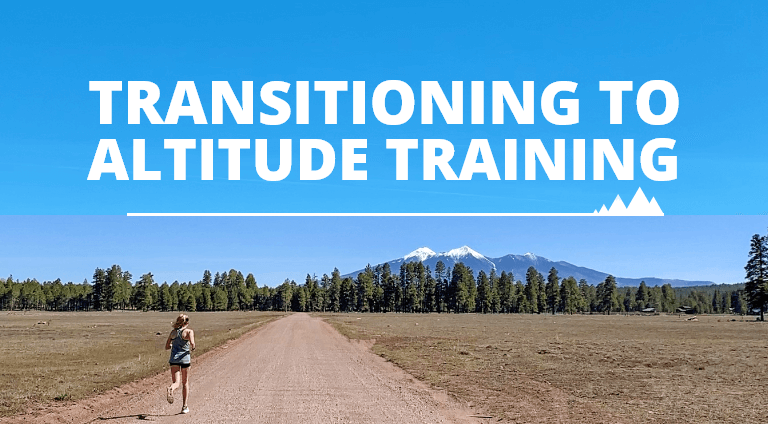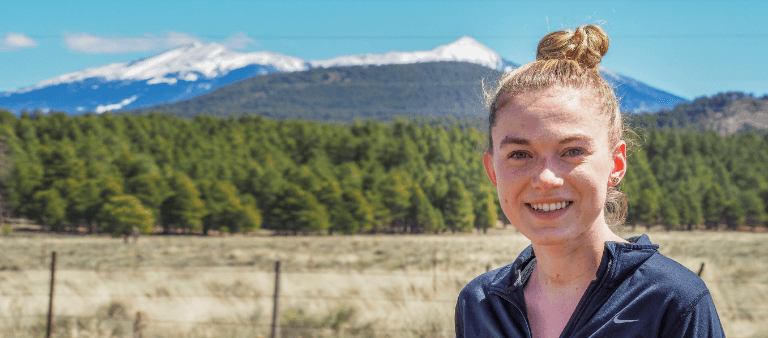ONLY $5.99 Shipping: Flat Rate Economy Shipping*
Free Shipping: Free Economy Shipping is available on orders over $100*
* Free Shipping is only available to valid addresses located in the contiguous U.S.
* Some exceptions apply
Come, run along with us as we share our joy of everything running.

After spending the majority of my life around sea level, in March I found myself facing a new challenge. Not only was I packing up and leaving my childhood home to move across the country, but I was moving to an area that was 7,000 ft. in elevation. How would this affect my training? How long would it take my body to adjust? These were questions I found myself asking and although I knew eventually the altitude would benefit my training, I was unsure what the adjustment period would look like.

Flagstaff, Arizona, my new home. Located at an elevation of 7,000 ft., filled with gorgeous landscapes, and soft surfaces to run on, Flagstaff has become one of the distance running meccas of the United States. Professional runners worldwide come to Flagstaff to train, whether that be moving, like myself, or for a short altitude camp in the off-season. Flagstaff offers the ability to live and train at a higher altitude with the benefit of lower elevations close by in Sedona or Camp Verde. This makes it an ideal place for runners.
When traveling to high altitudes, people refer to the air as being “thinner.” This simply means the air pressure is lower, and therefore, less oxygen is available to be used by the body. At about 10,000 ft. in elevation, the body expends on average 25% more energy to accomplish the same task then at sea level. Generally, we refer to training at altitude when the elevation is above 6,000 ft., this is when we begin to notice physiological changes in our training. The benefits of altitude training occur when the body "drops back down" to sea level, which is a higher oxygen environment.

Initially, when moving to a higher altitude, the body responds to the decreased oxygen available by increasing your breathing rate and heart rate. This means you should not be alarmed when your heart rate monitor reads higher than normal.
As your body begins to adjust to the lower oxygen environment, it increases the number of red blood cells available to allow a more efficient transfer of oxygen through the bloodstream. This causes blood to become more viscous, which in turn makes the heart work harder to pump blood through the body. So, not only does your body become more efficient at transporting oxygen, but your heart actually becomes stronger as well.
While training at altitude can have substantial benefits for runners, there are also cautions that should not be ignored. When the body transitions to altitude, it is not uncommon to experience what is known as “altitude sickness”. This is characterized by headaches, dizziness, shortness of breath, loss of appetite, and dehydration. Because of this, it is essential to really focus on hydration when transitioning to a high altitude environment. Also, as your body is in the process of producing more red blood cells, it is essential to focus on iron intake and possibly supplementation during that time.
To experience the true benefit of altitude training, a runner must live and train at altitude for at least 3-6 weeks. Once at altitude, you should expect to slow down training runs and plan for a small decrease of 10-20% in weekly mileage. While you may experience what appears as a decreased fitness level, don’t be discouraged as it is completely normal to slow down by at least 30 seconds per mile for an easy run.
Even once an athlete has adjusted to altitude training, workouts must still be adapted for the conditions. Runners should plan for more recovery in between intervals, and paces must be altered to account for the added elevation and decreased oxygen. There are many “altitude converters” online that can adjust your sea-level paces for the altitude you are training at. These can be especially useful before you begin your workout.
Although I had researched the adjustment to high altitude and tried to prepare myself for what would seem like a setback in my training, the transition to 7,000 ft. hit me much harder than I anticipated. Even with my roommates (all runners) constantly reminding me that things are "harder up here" and everyone takes time to adjust, I found myself frustrated and angry with my body for not being able to perform the same way it did at sea level.

My transition to the higher altitude was far from easy. Every run felt as though I was running a race. I found myself gasping for air at the slightest bump in the road or at a 4 ft. incline! For the first time ever, I was stopping to walk or catch my breath on even a small hill. Each one seemed like climbing a mountain! For weeks, I woke up every day and my goal was simply to "survive" each run. I tried not to worry about pace and just attempted to get the miles in.
While the runs continued to feel difficult, gradually, I noticed my pace begin to increase. The effort was the same, but at least the times were coming down. Finally, I was starting to feel like myself again. After 6 weeks of “flat” (nothing is truly flat here in Flagstaff) runs, I decided it was time to graduate to running up a hill! While extremely challenging, I made it up the 300 ft. increase in elevation without stopping once. I even earned a crown for the segment on Strava!
The first mile of every run continues to be a challenge and I've heard this is something that never truly goes away. However, I am adjusting and starting to acclimate to life in the mountains! The process of adjusting to altitude training has been extremely humbling and has taught me to appreciate how much my body is capable of adapting and overcoming. I can’t wait to see what training in the clouds does for me once I am able to toe the starting line again. Until then, there are miles and miles of trails to explore!